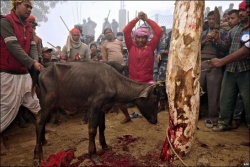Animal sacrifice
One of the central rites of Brahmanism during the Buddha’s time was the sacrifice (yāga or yañña) which sometimes included the slaughter of animals. The Vedas describe in detail how these sacrifices should be conducted if the gods were to find them acceptable. Some of these rites could be very elaborate and very expensive. The Tipiṭaka records one sacrifice conducted by a brahman named Uggatasarīra during which’five hundred bulls, five hundred steers and numerous heifers, goats and rams were brought to the sacrificial post for slaughter’ (A.IV,41). The Buddha criticized these bloody rituals as being wasteful, ineffective and cruel (A.II,42). He maintained that those who conduct sacrifices make negative kamma for themselves even before they have set up the sacrificial post (yūpa), ignited the sacred fire (aggi) and given instructions for the animals to be slaughtered (A.IV,42). He repudiated the killing of the animals, the felling of trees to make the sacrificial posts and the threatening and beating of the slaves as they were driven to do the preparations ‘with tear-stained faces’ (A.II,207-8). He also made a plea for such sacrifices to be replaced by charity towards virtuous ascetics and monks (D.I,144). In time the Buddhist critique of animal sacrifice led to them being phased out within Brahmanism. Ghee, grain, milk or honey was thrown into the sacred fire as a substitute for the slaughtered animals. As Hinduism evolved it adopted harmlessness (ahiṃsā) as one of its most important moral principles, although a good number of Hindu sects continue to practice animal sacrifice even today.
